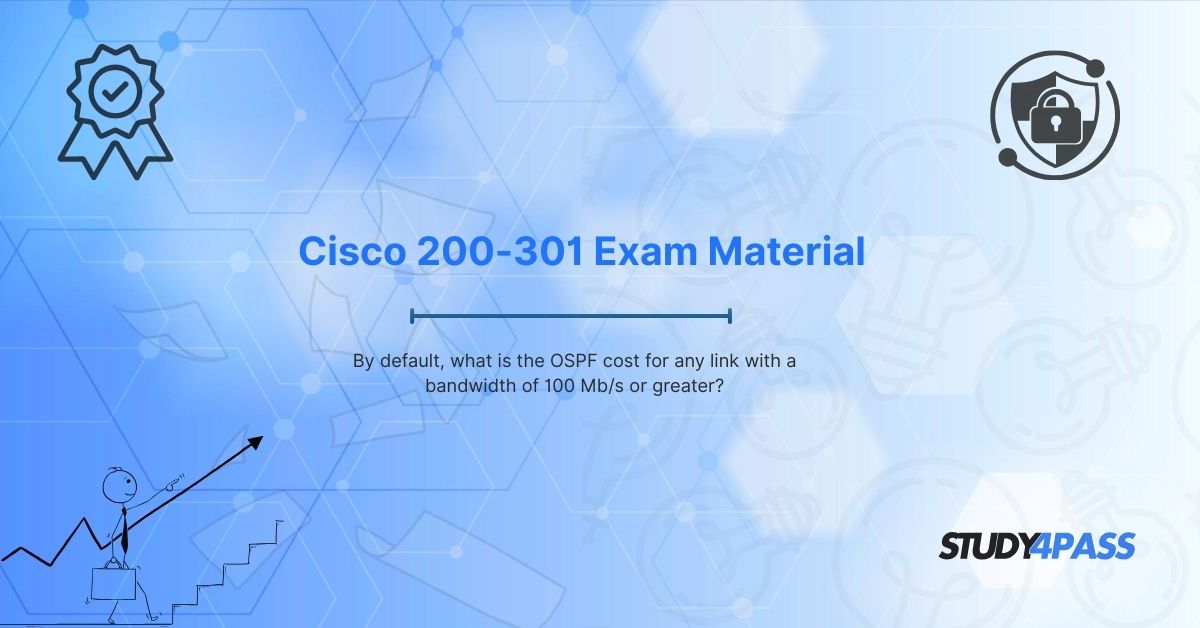Introduction
The Open Shortest Path First (OSPF) protocol is a widely used link-state routing protocol in IP networks. One of the key aspects of OSPF is its metric system, known as cost, which determines the best path for routing traffic. A common question in the Cisco CCNA 200-301 exam and CCNA 3 v7 Modules 1 – 2 exam is:
"By default, what is the OSPF cost for any link with a bandwidth of 100 Mb/s or greater?"
This article will provide a detailed explanation of OSPF cost calculation, focusing on high-bandwidth links (100 Mbps and above). Additionally, we will discuss how platforms like Study4Pass can help you prepare effectively for Cisco certification exams.
OSPF Cost Calculation Basics
OSPF uses cost as its routing metric, which is inversely proportional to the bandwidth of the link. The formula for calculating OSPF cost is:
Cost=Reference BandwidthInterface Bandwidth (in Mbps)Cost=Interface Bandwidth (in Mbps)Reference Bandwidth
Default Reference Bandwidth
· Cisco routers use a default reference bandwidth of 100 Mbps (100,000,000 bps).
· This means that any link with a bandwidth of 100 Mbps or higher will have a cost calculated as follows:
Cost=100 Mbps100 Mbps=1Cost=100 Mbps100 Mbps=1
For links with bandwidth greater than 100 Mbps, the cost remains 1 by default because OSPF does not use fractional costs.
Examples of OSPF Cost for Different Bandwidths
|
Bandwidth |
OSPF Cost Calculation |
Default OSPF Cost |
|
10 Mbps |
100 / 10 = 10 |
10 |
|
100 Mbps |
100 / 100 = 1 |
1 |
|
1 Gbps (1000 Mbps) |
100 / 1000 = 0.1 → Rounded to 1 |
1 |
|
10 Gbps (10000 Mbps) |
100 / 10000 = 0.01 → Rounded to 1 |
1 |
As seen in the table, any link with 100 Mbps or higher bandwidth has a default OSPF cost of 1.
Why Does OSPF Use Cost 1 for High-Speed Links?
1. Historical Reference Bandwidth Limitation
o When OSPF was designed, networks rarely exceeded 100 Mbps.
o The reference bandwidth was set to 100 Mbps, making it the baseline for cost calculation.
2. No Fractional Costs
o OSPF uses integer values for cost.
o Even if a link is 1 Gbps (1000 Mbps), the calculated cost (0.1) is rounded up to 1.
3. Modern Networks Require Adjustment
o With the rise of 10 Gbps, 40 Gbps, and 100 Gbps links, the default reference bandwidth is outdated.
o Cisco recommends adjusting the reference bandwidth to a higher value (e.g., 10,000 Mbps) for accurate path selection.
How to Modify OSPF Reference Bandwidth?
To ensure OSPF correctly calculates costs for high-speed networks, you can adjust the reference bandwidth using the following command:
Router(config)# router ospf 1
Router(config-router)# auto-cost reference-bandwidth 10000
(Sets the reference bandwidth to 10 Gbps)
Note: All routers in the OSPF domain must use the same reference bandwidth to avoid routing inconsistencies.
Practical Implications for CCNA Exam
Understanding OSPF cost is crucial for:
Designing efficient networks – Ensures traffic takes the best path.
Troubleshooting routing issues – Incorrect costs can lead to suboptimal routing.
Passing Cisco exams – OSPF metrics are a key topic in CCNA 200-301 and CCNA 3 v7.
How Study4Pass Helps You Master OSPF and CCNA Topics?
Preparing for Cisco exams requires reliable study materials and practice tests. Study4Pass is an excellent platform for CCNA candidates because:
Comprehensive Study Guides – Detailed explanations of OSPF, EIGRP, BGP, and other key topics.
Real Exam Simulations – Practice tests that mimic the CCNA 200-301 exam format.
Up-to-Date Content – Covers the latest Cisco exam objectives.
Expert Explanations – Clarifies complex networking concepts with examples.
By using Study4Pass, you can confidently tackle OSPF-related questions and pass your CCNA exam on the first attempt.
Final Verdicts
The default OSPF cost for any link with 100 Mbps or higher bandwidth is 1.
This is due to the default reference bandwidth of 100 Mbps and OSPF’s use of integer costs.
For modern high-speed networks, adjust the reference bandwidth using the auto-cost reference-bandwidth command.
Platforms like Study4Pass provide essential resources to master OSPF and other CCNA topics.
For more in-depth CCNA preparation, visit Study4Pass today!
Special Discount: Offer Valid For Limited Time “CCNA 200-301 Practice Test”
Sample Questions for Cisco 200-301 Certification
Actual Exam Questions For Cisco's 200-301 Latest Exam
1. By default, what is the OSPF cost for a link with a bandwidth of 100 Mbps or greater?
A) 1
B) 10
C) 100
D) 1000
2. Which bandwidth value marks the threshold where OSPF assigns a default cost of 1?
A) 10 Mbps
B) 100 Mbps
C) 1 Gbps
D) 10 Gbps
3. What is the OSPF cost formula used to calculate the default cost of an interface?
A) Cost = Bandwidth (in Mbps)
B) Cost = 100 / Bandwidth (in Mbps)
C) Cost = Reference Bandwidth (100 Mbps) / Interface Bandwidth
D) Cost = 1 for all links
4. If an interface has a bandwidth of 1 Gbps, what is its default OSPF cost?
A) 1
B) 0.1
C) 10
D) 100
5. Which of the following statements is true regarding OSPF cost calculation?
A) Higher bandwidth links always have a higher OSPF cost.
B) The default OSPF cost for 100 Mbps or faster links is 1.
C) OSPF cost is manually configured and not based on bandwidth.
D) The reference bandwidth in OSPF is fixed at 1 Gbps.


